Salomon Smith Barney
Chemical Conference
December 3, 2002
John E. Lushefski
Senior Vice President and CFO

1
Good morning to all and welcome to the Millennium Chemicals presentation.
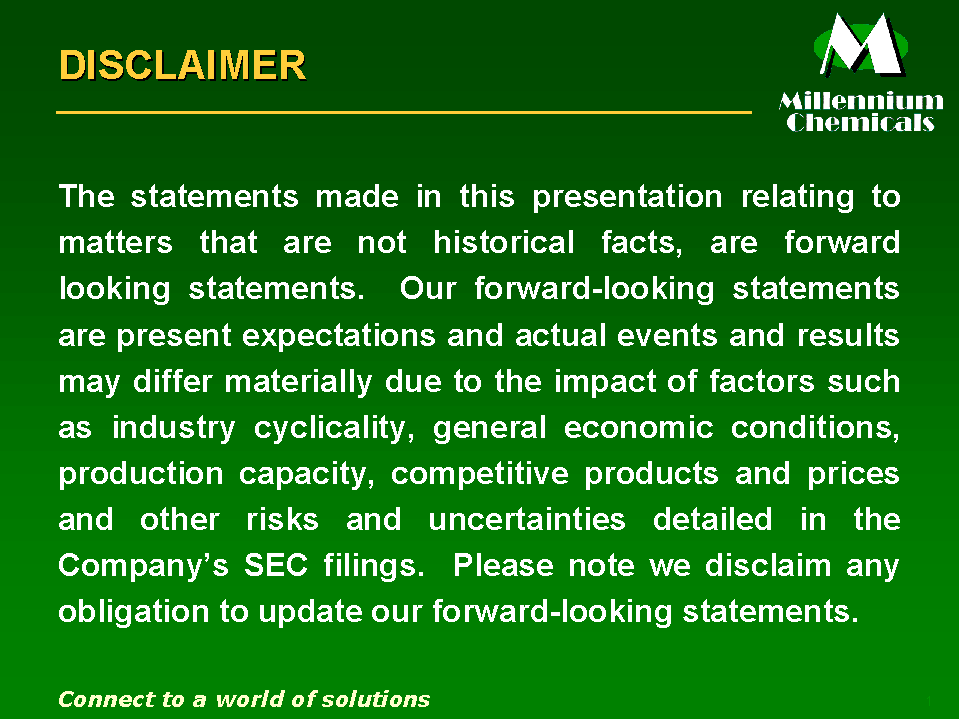
2
Before we start, our lawyers asked me to preface with our safe harbor legal statement: The statements made in this presentation relating to matters that are not historical facts, are forward looking statements.
Our forward-looking statements are present expectations and actual events and results may differ materially due to the impact of factors such as industry cyclicality, general economic conditions, production capacity, competitive products and prices and other risks and uncertainties detailed in the Company’s SEC filings. Please note we disclaim any obligation to update our forward-looking statements.
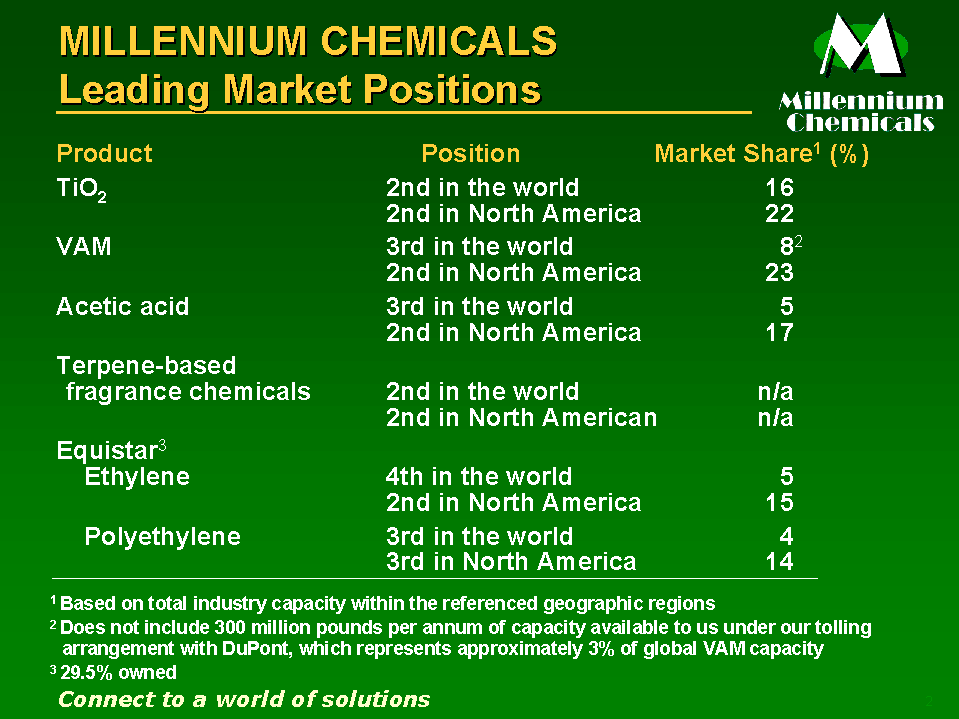
3
While many of you know that we are the world’s second largest producer of titanium dioxide, that is not the only market where we have a significant share, as you can see from this table.
Scale and market share are important in the chemicals business, and we can claim one of the top three positions in each of our wholly owned business sectors.
Equistar, our petrochemical partnership with Lyondell Chemicals, also is a major market player, both in North America and worldwide. We own 29.5% of that partnership.
These positions allow us to pursue economies of scale and offer a comprehensive slate of products for our customers in all major geographic markets.
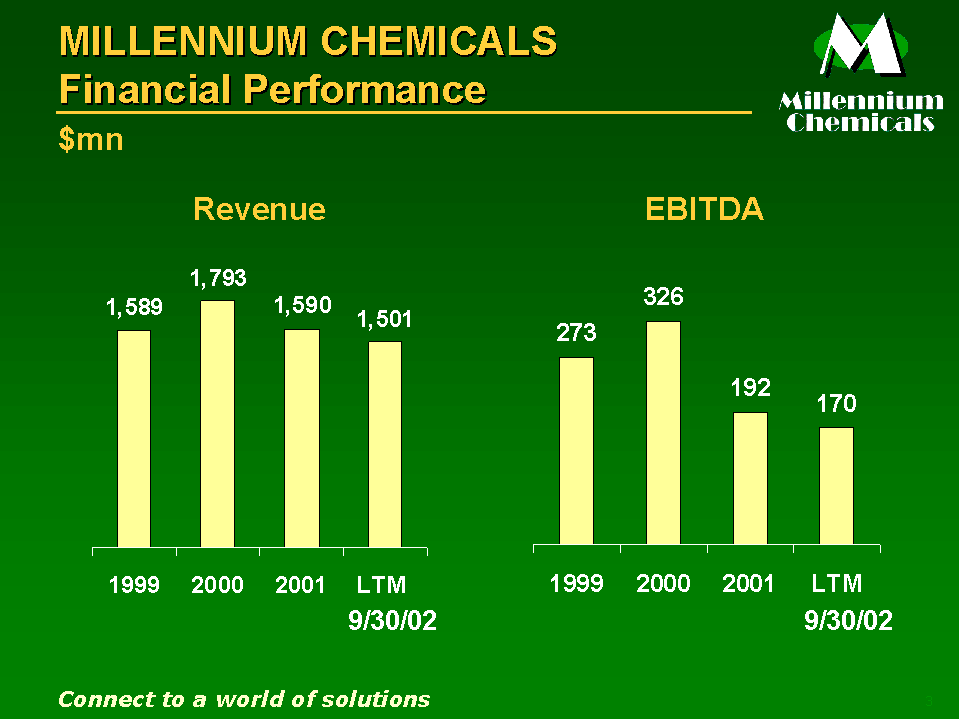
4
Millennium, which is publicly traded on the New York Stock Exchange, has world-wide revenue from wholly owned operations of just over $1.5 billion.
Earnings before interest, taxes, depreciation and amortization, or EBITDA, have been lower in the last eighteen months along with most chemical producers in the wake of a very difficult worldwide marketplace for most manufactured goods, and chemicals in particular.
For the last twelve months, EBITDA of $170 million, was just over half of the EBITDA we earned as recently as calendar 2000. These figures presented here exclude results from Equistar, although the picture would be similar if we presented pro forma EBITDA including our 29.5% share of partnership earnings.

5
The good news is that business is slowly improving from the trough of the first quarter of this year for both our wholly owned businesses and Equistar, included on a pro forma basis on this chart.
We are certainly not out of the woods yet, and higher oil prices and weaker demand is once again hurting Equistar’s results this quarter, but a combination of recent price increases and aggressive cost reduction efforts have benefited our titanium dioxide and acetyls businesses over the last several months.
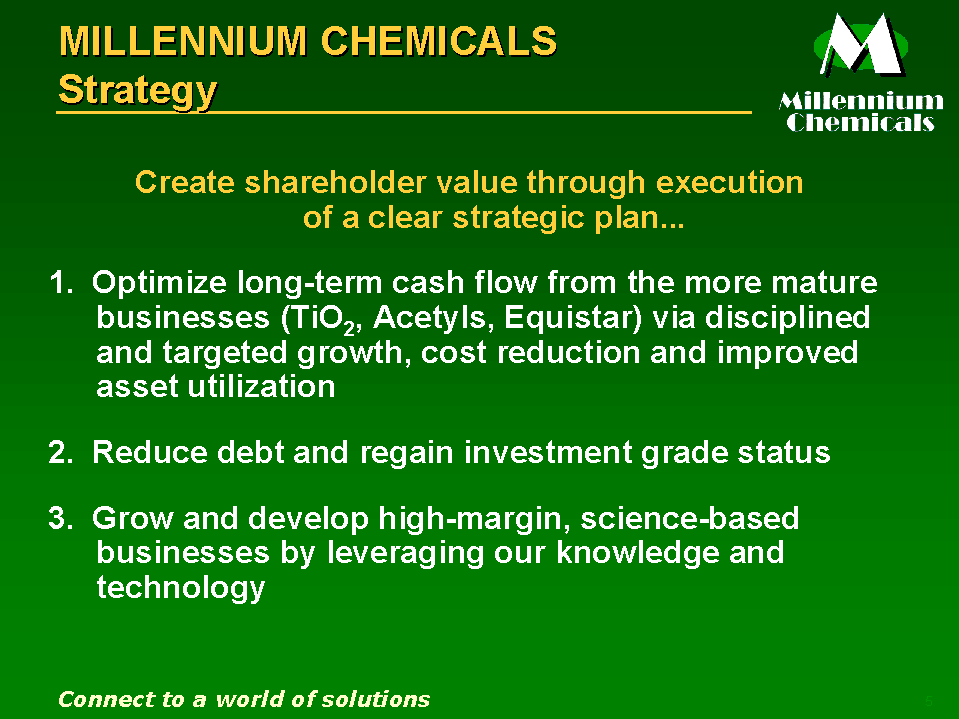
6
Turning to strategy, a little over 20 months ago we performed an in-depth analysis of the winners and losers in the chemical industry and arrived at a not surprising conclusion: Profitable growth is the key to market valuation. Accordingly, our strategic intent has evolved to focus on creating differential value by following a strategy designed to:
- Optimize cash flow from our more mature businesses through disciplined and targeted growth, cost reduction and improved asset utilization
- Utilize excess cash flow to reduce debt and regain investment grade credit status; and
- Leverage our existing knowledge and competencies to grow and develop higher-margin, science-based businesses.
Let me first describe our execution of that first strategic objective.
Right now the major portion of our profit comes from businesses that are fairly mature and cyclical to varying degrees. High-volume TiO2, acetyls and our participation in the ethylene and ethylene derivatives business through Equistar fall into this category.
Let me briefly discuss those businesses.
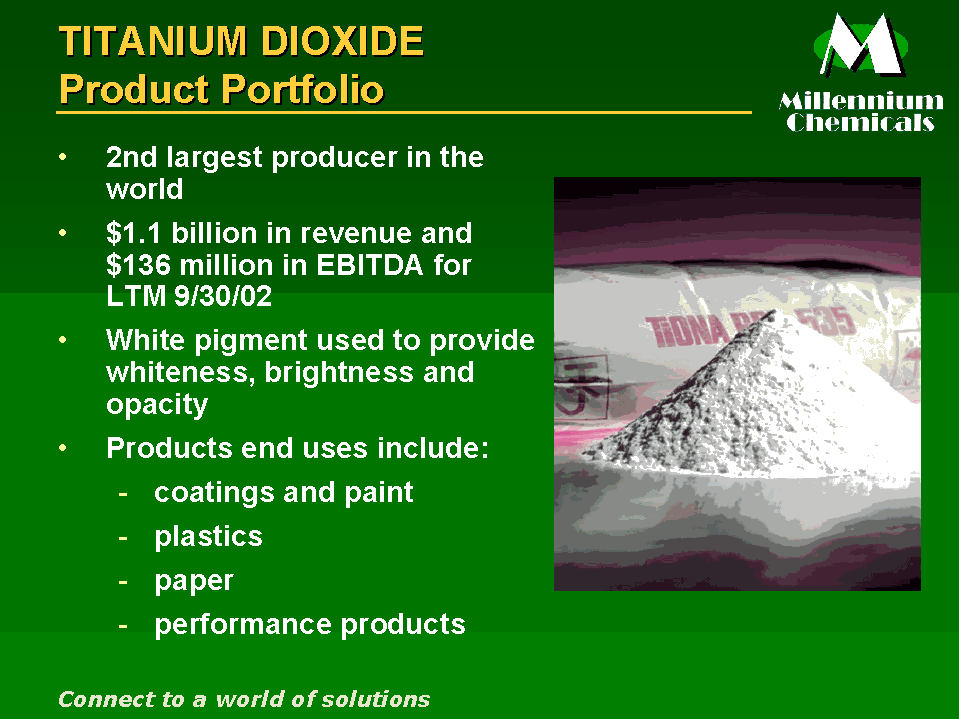
7
We are the world’s second-largest producer of TiO2, behind DuPont. TiO2 is a white pigment used to impart whiteness, brightness and opacity in a wide range of products, including coatings and paints, plastics, paper and rubber.
About three-quarters of our 690,000 metric ton capacity uses the chloride process to make TiO2, with the other third using a sulfate process. The chloride process is generally preferred for the coatings and plastics applications, while sulfate is used in many paper and some coatings and plastics applications.
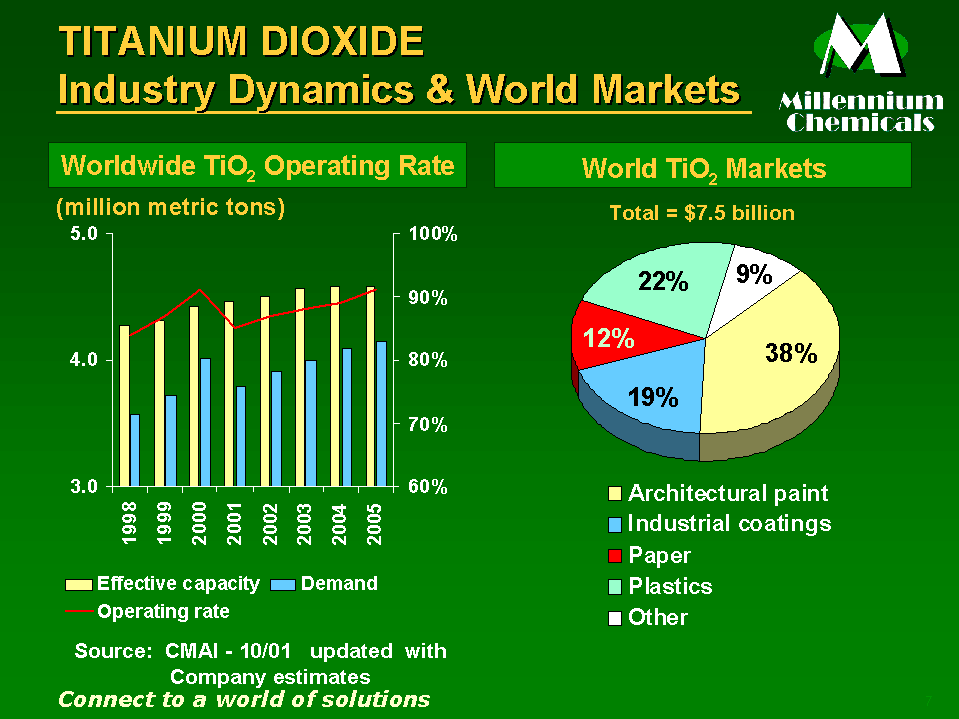
8
This graphic gives a snapshot of the world marketplace for TiO2, including a supply/demand forecast. That forecast shows a rise to operating rates of about 90%, and bodes extremely well for the world’s second largest producer of TiO2. Even if that forecast is a little off, the direction to higher operating rates is clear.
Improved industry operating rates have lead to a favorable pricing environment for TiO2 in the last nine months.
You can see on the right how the $7.5 billion TiO2 market breaks down by end use. These markets are fairly mature and GDP-driven although per-capita consumption of TiO2 tends to increase as quality of life improves in a particular country or geographic region.
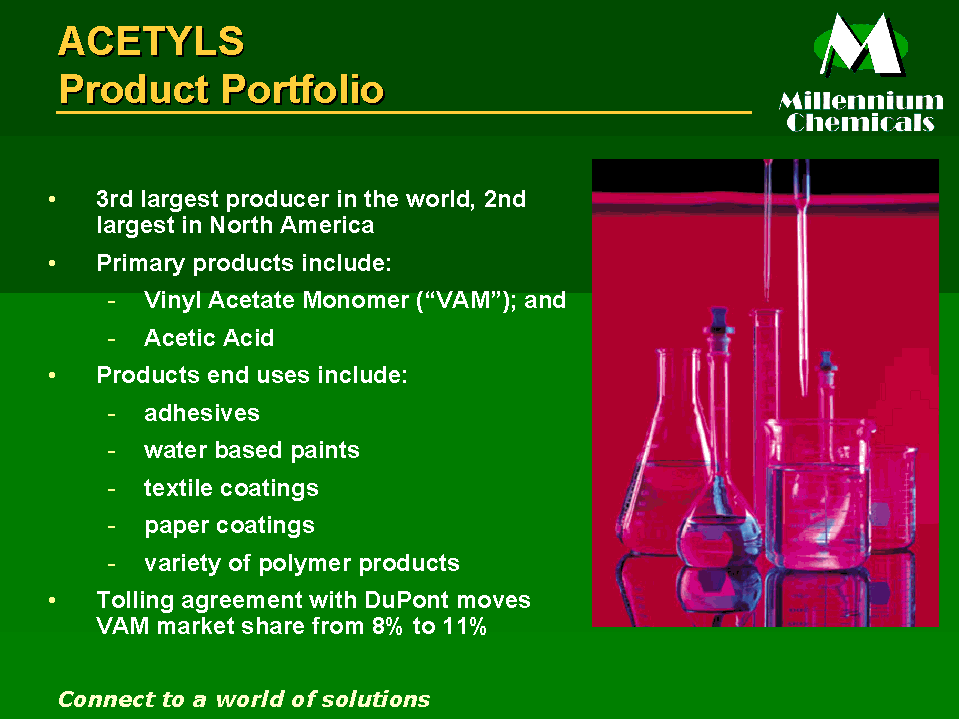
9
Millennium is also the 3rd largest producer of acetyls in the world and the 2nd largest in North America.
Its principal products are vinyl acetate monomer and acetic acid used in a variety of adhesive, paint, coatings, and polymer products. A tolling agreement with DuPont provides for an additional 300 million lbs. of VAM capacity, increasing our worldwide market share to about 11%. This agreement extends the acetyls value chain by further processing about 200 million pounds of acetic acid into VAM at DuPont which is then marketed by Millennium’s sales force.
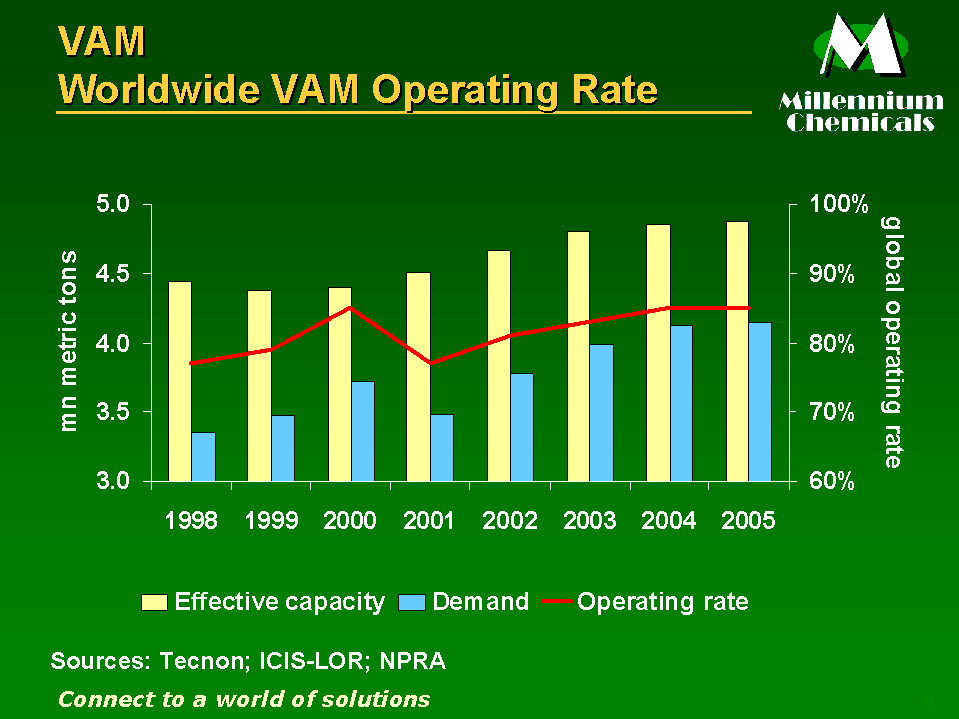
10
With respect to our primary product, VAM, demand is forecast to also increase about 3.0% over the next four years with capacity growing by about half that, or 1.5%. This will cause operating rates to increase from current levels and provide an advantageous pricing environment.
Recently prices have been increasing and are keeping pace with recent increases in the price of natural gas and ethylene, the main cost drivers.
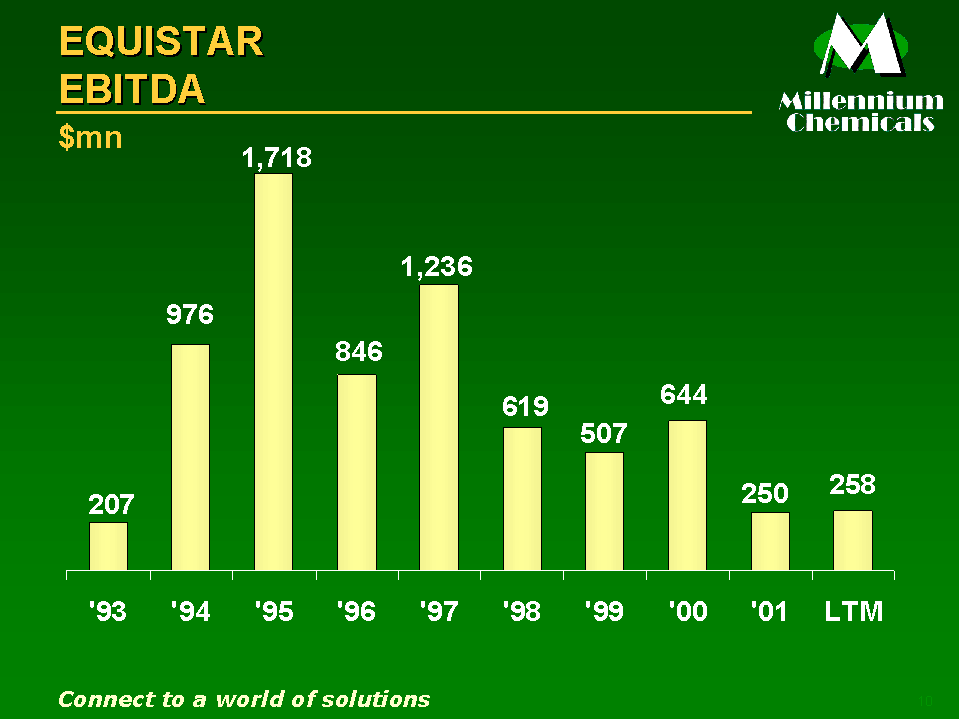
11
The last segment of our more mature businesses which are being run to optimize cash flow and grow in a disciplined manner is our petrochemical partnership with Lyondell. These proforma EBITDA numbers for the Equistar assets demonstrate both the cyclicality of the ethylene/polymers business and the potential for substantial cash distributions to Millennium as we come out of the current cyclical trough and head toward the next peak. We anticipate the next peak will be in the 2004 – 2005 timeframe. To quantify the potential distributions to Millennium, you can subtract from those EBITDA numbers about $400 million per year for normalized debt service and capex and then multiply by our 29.5% ownership percentage. For example, averaging the 1995 peak through the 2001 trough, the average distribution would be about $125 million per year. We expect the second half of 2002 to mark the inflection point in the current cycle and project a resumption of cash distributions from Equistar by late 2003 or early 2004.
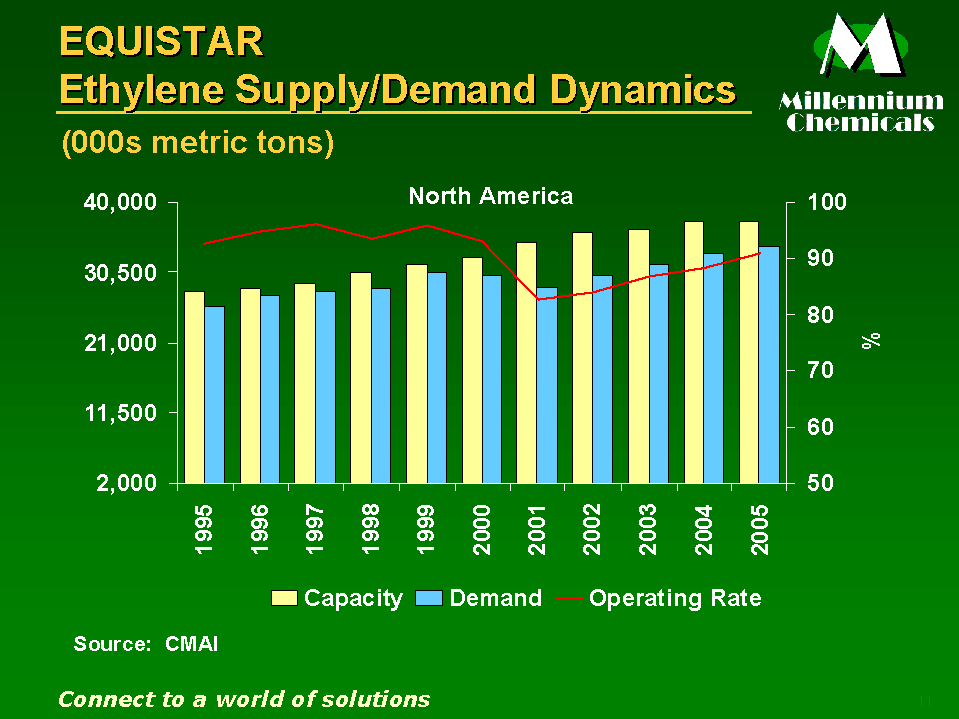
12
The supply/demand dynamics for ethylene, which also drives polyethylene pricing, is also favorable over the next few years with a peak expected in the 2004-2005 timeframe. After significant additions to North American capacity in 2000 and 2001, projected additions are limited for several years.
Although analysts and industry consultant’s forecasts differ as to timing and height of the peak, most agree that operating rates will increase over the next several years.
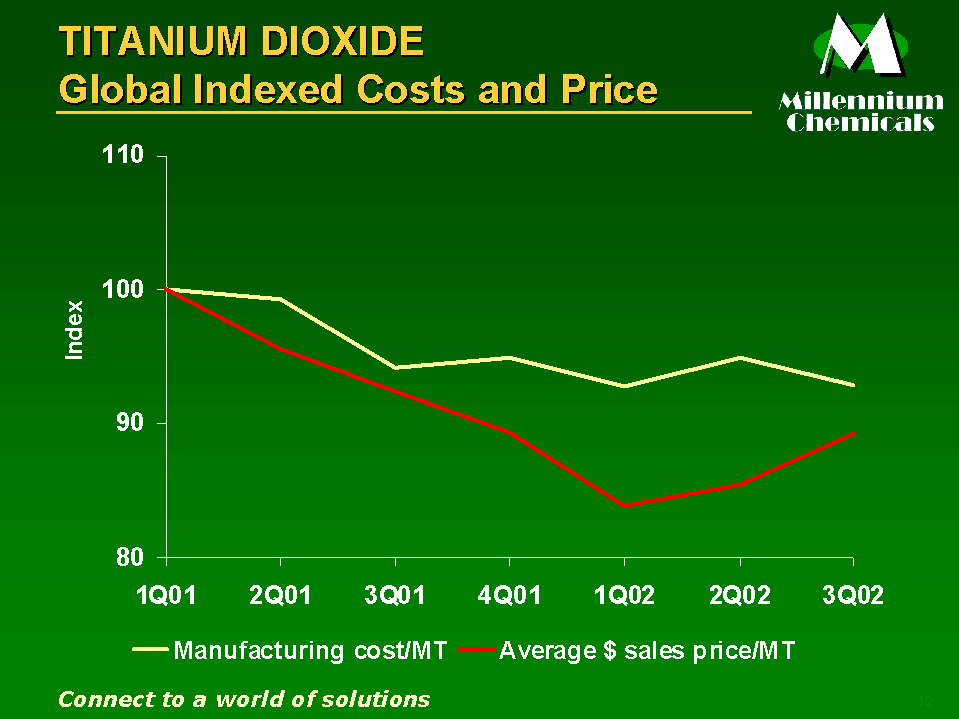
13
It’s great to see forecasts of improving operating rates, but we have also been working very hard at Millennium on the cost element of the profit equation. The next few slides demonstrate our progress on cost reduction.
The dramatic decline in US dollar equivalent global pricing for TiO2 that we experienced in 2001 and into 2002 could have easily threatened our very existence as a company had we not aggressively reduced our cost base.
This chart shows that we are fighting hard to return to acceptable economic returns by reducing manufacturing costs per ton even though the price of our raw materials during this time frame went up.
Current margins in TiO2are still unacceptably low versus reinvestment economics, but I can assure everyone in this room we have never worked harder at reducing costs than we are working now.
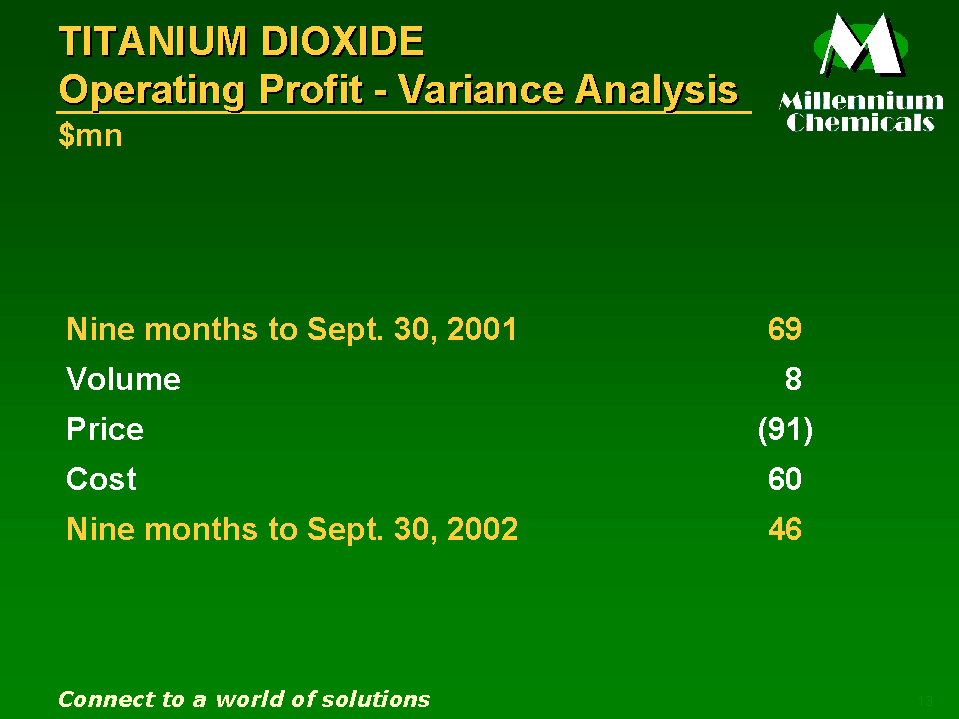
14
A graph really doesn’t do justice to just how difficult the last nine months have been in this business and the extraordinary response the people of Millennium have made to these challenging conditions. Numbers can give you some perspective.
As you can see here, the decline in average global pricing in TiO2 resulted in a reduction of operating earnings for Millennium of an incredible $91 million when compared to the first nine months of 2001, itself far from a peak period.
Our employees managed to reduce costs for that period by $60 million, a very significant achievement.
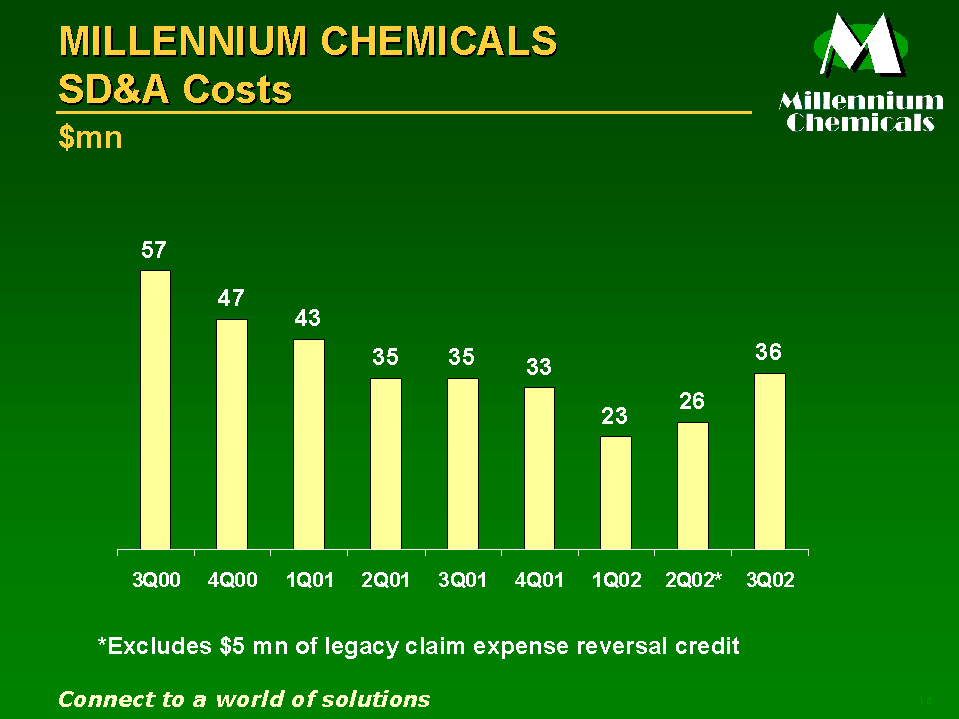
15
Those impressive cost reductions were achieved in the Ti02business alone. Looking across all of Millennium you can see that our overhead cost structure overall shows a similar trend since the end of 2000. While the last quarter showed a slight increase due to the timing for accruing compensation costs, this sustainable level is about 37% lower than the similar quarter just twenty-four months ago. The number of employees at Millennium is about 16% less today than at the beginning of 2001.
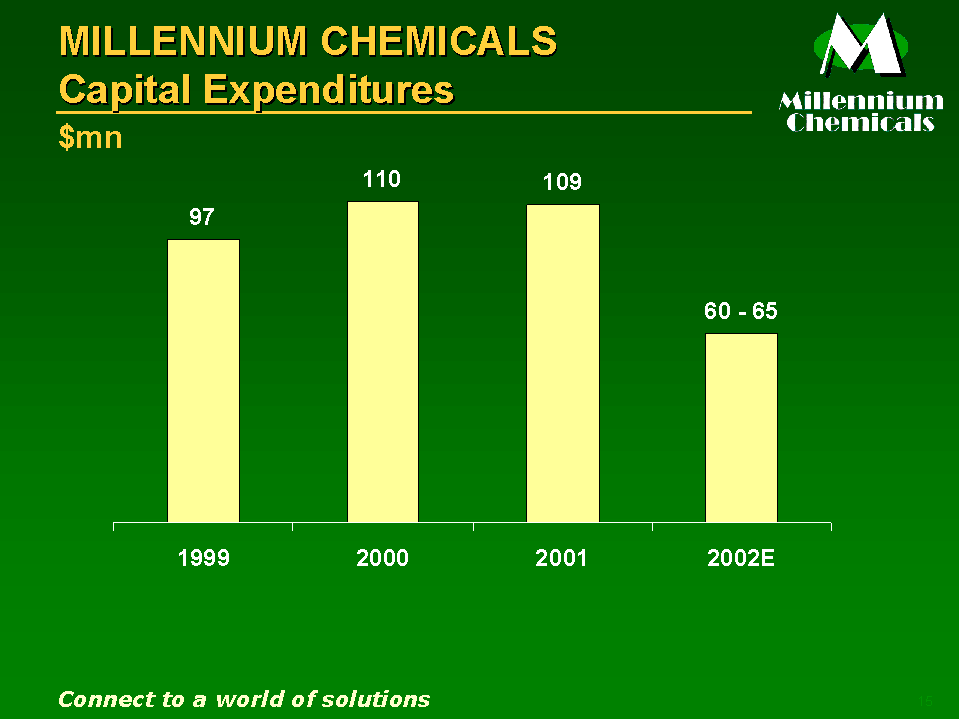
16
During the recent downturn we've also dramatically reduced capital investment.
Like Millennium, many of our competitors have drastically cut or deferred spending in the last few years, which will cause a tightening of future operating rates.
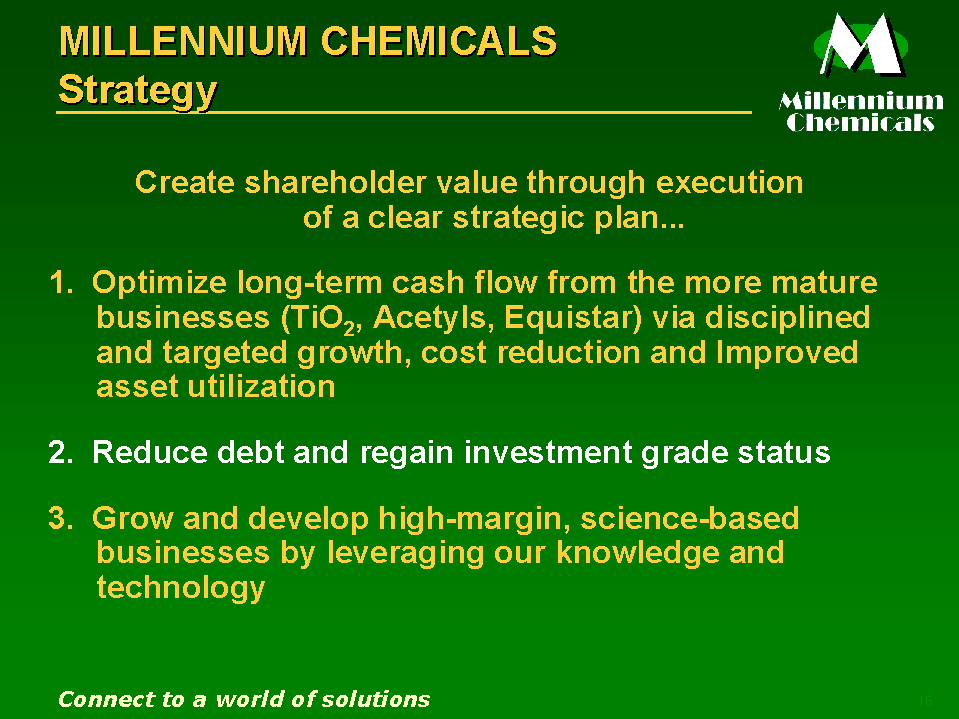
17
The second leg of our strategy is to reduce debt and regain an investment grade bond rating status from Moody’s. We are presently rated investment grade from Standard & Poors. This split rating increases our cost of borrowing and limits our financial flexibility.
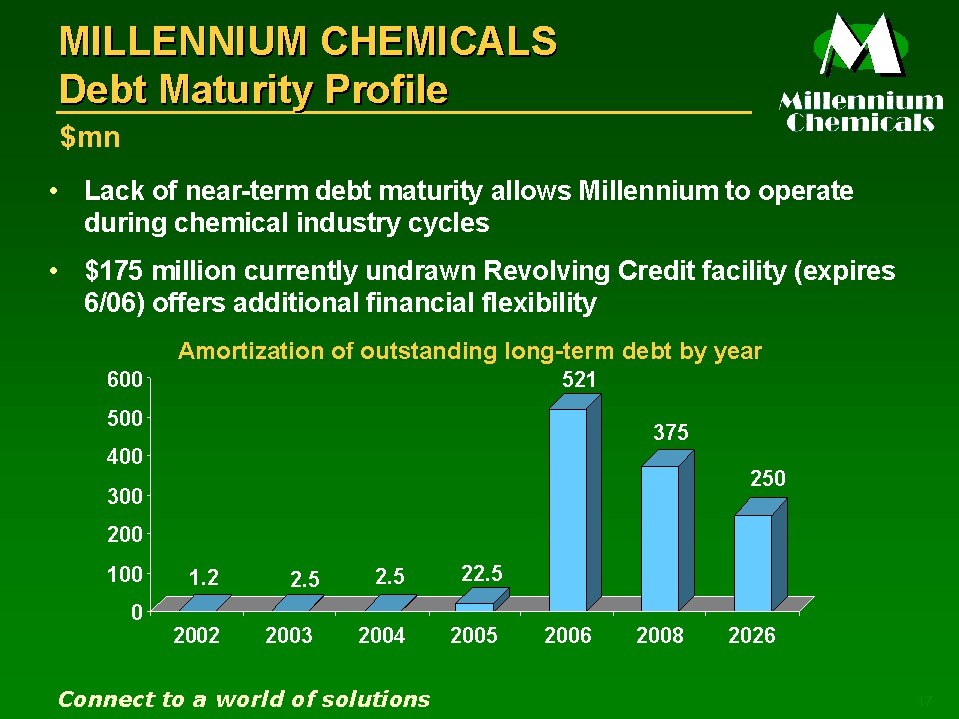
18
The good news is that we have positioned our debt maturities such that there is little or no risk of a liquidity issue in the near term. We have no substantial debt payments that come due until mid-2006 and we expect an improving profit environment for our businesses between now and then.
Until that profit improvement becomes clear, we will be very cautious in how we spend.
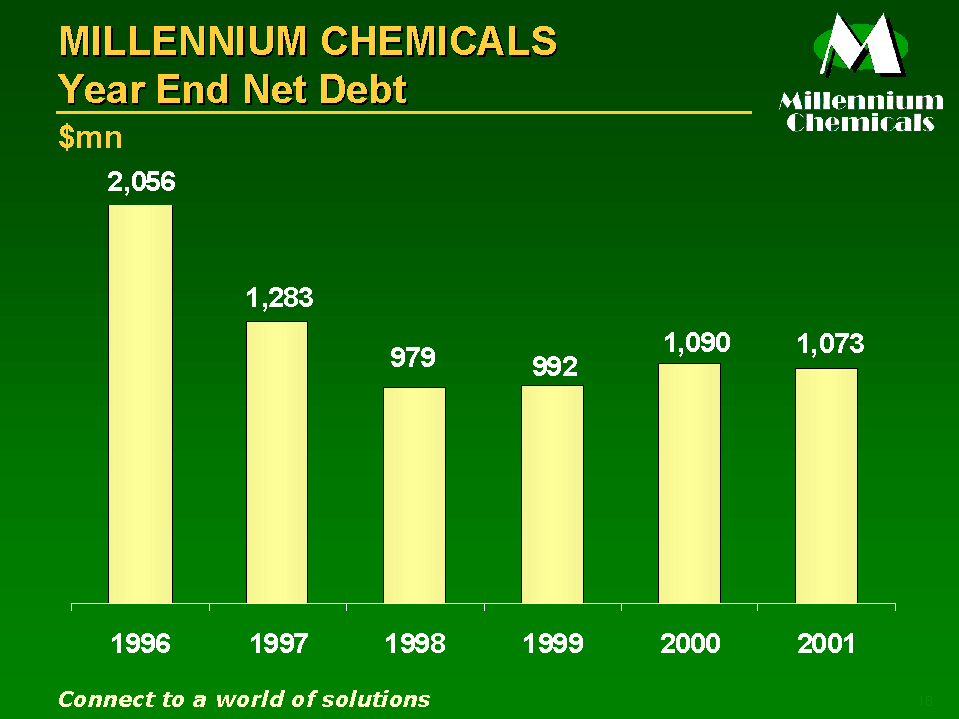
19
You can see from this graph that net debt is much lower today than it was in the two years following our formation as a separate public company. Net debt now stands at about $1.1 billion and our goal over the next few years is to reduce that figure and improve our credit statistics.
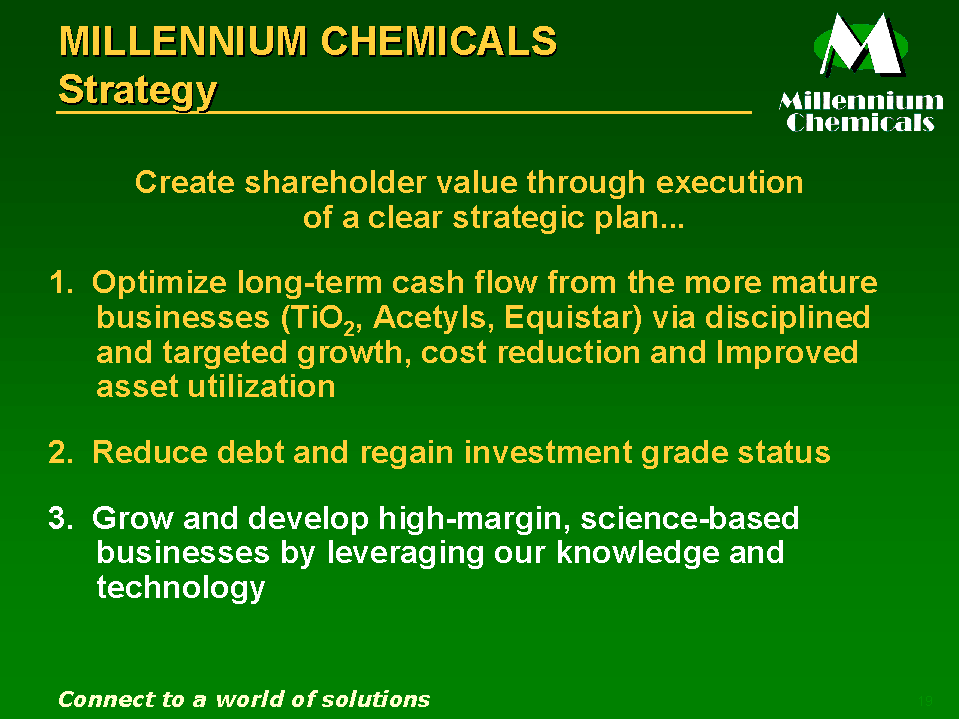
20
Now I’ll turn the podium over to Bob Lee who will discuss the third leg of Millennium’s strategy relating to growth and development. Thank you for your attention this morning.
Robert E. Lee
Executive Vice President - Growth and Development
Thanks Jack...
Switching gears, in the time that is left, I’m going to talk about Millennium’s third strategy. Millennium has some existing and developing businesses identified as higher-growth and higher-margin business extensions that leverage our core competencies and technologies. These activities are small now but offer tremendous opportunities over the next several years.
We are relying on our existing skills in synthetic molecule chemistry, small-particle science, catalysis and process technologies to drive organic growth, complimented where warranted by alliances and, potentially, small focused acquisitions when a low-risk opportunity presents itself.
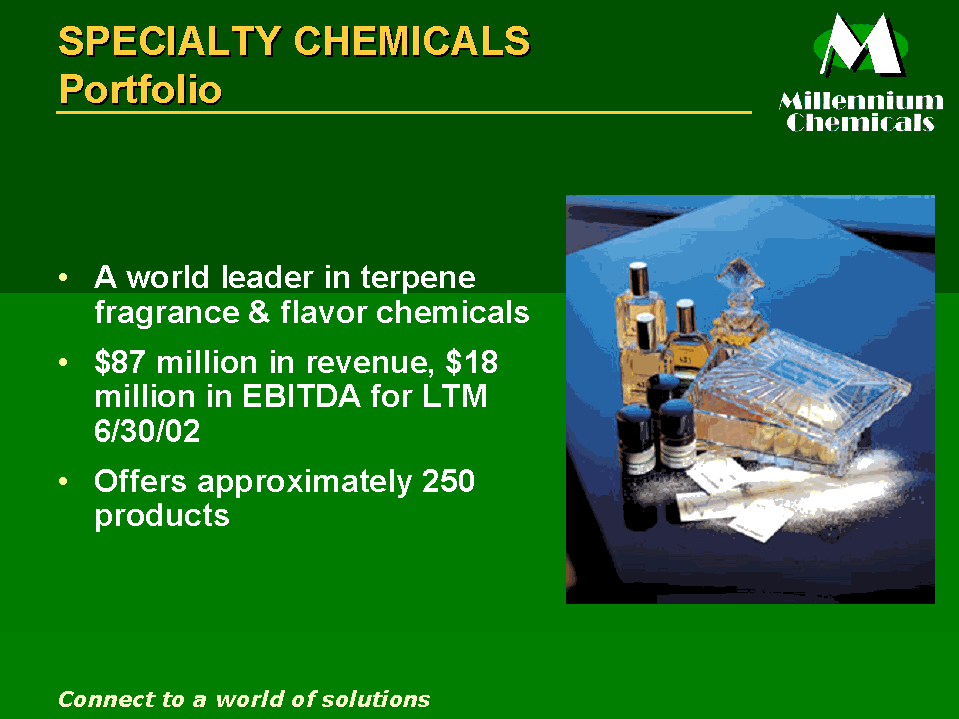
21
Our Specialty fragrance and flavor chemicals business is an example of a higher-margin business with both established and developing product lines. EBITDA margins here are a little over 20% over the last twelve months, despite recent issues of overcapacity and customer consolidation in the fragrance chemicals sector.
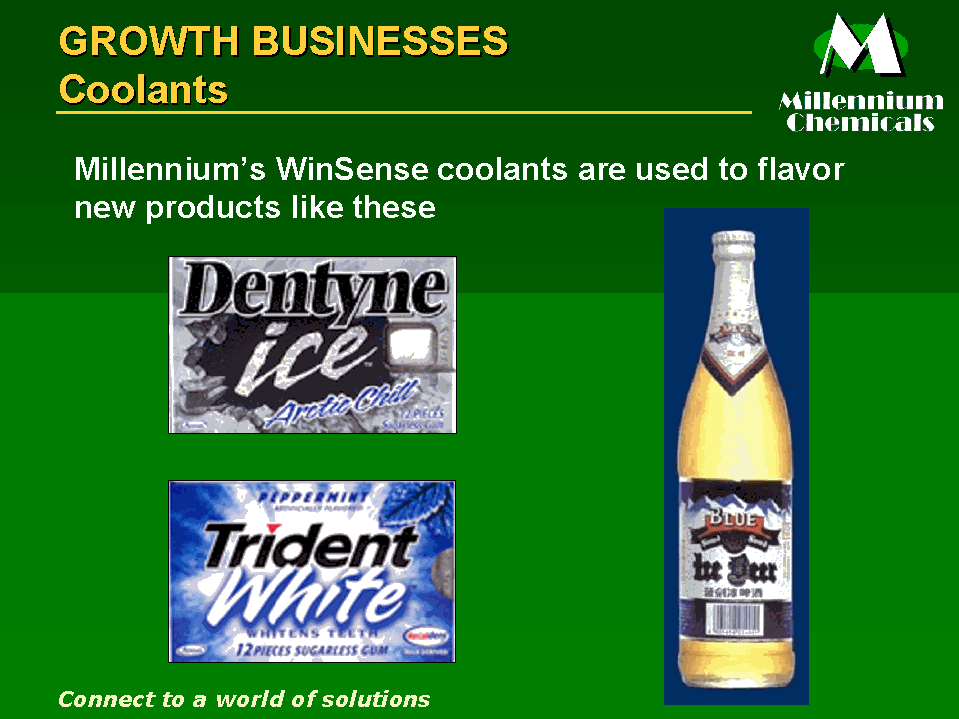
22
Recent investment in R&D and capacity has instead been focused on new flavor and coolant chemicals. Those product lines were virtually insignificant in the past, but are now growing rapidly and now account for over 18% of our gross margin. The coolants we produce that go into products like these are an especially important part of this profitable growth.
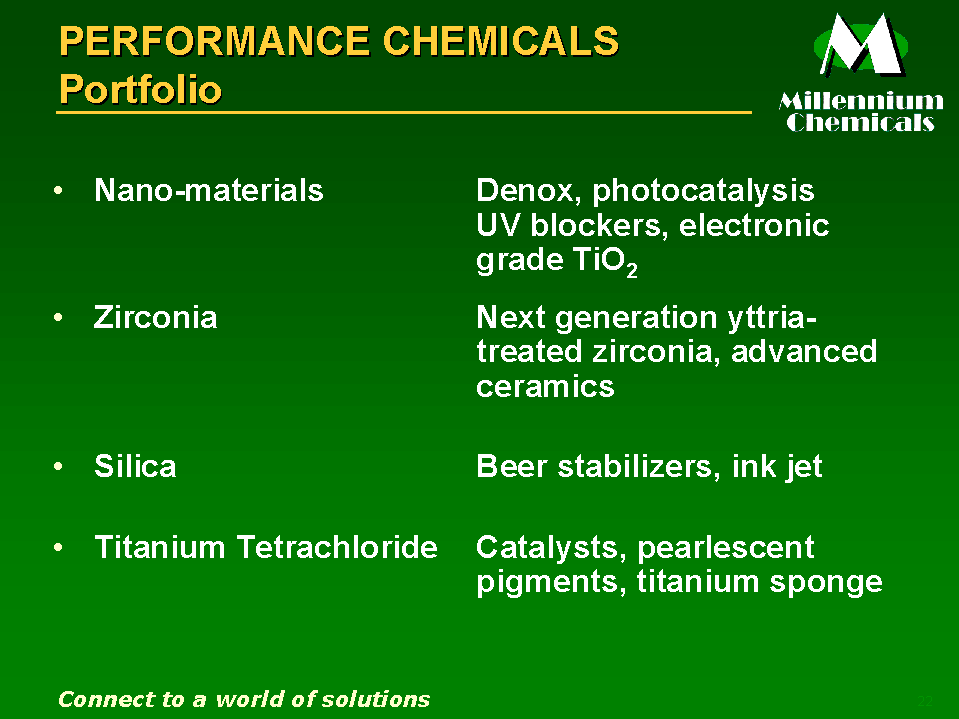
23
An already established science-based, higher growth business is our Performance Chemicals portfolio that is included in our TiO2 and related products segment disclosure. This business is currently generating sales of about $75 million and EBITDA margins in the mid-twenties. This slide lists several of our current products and the markets that we are either already participating in or are actively developing.
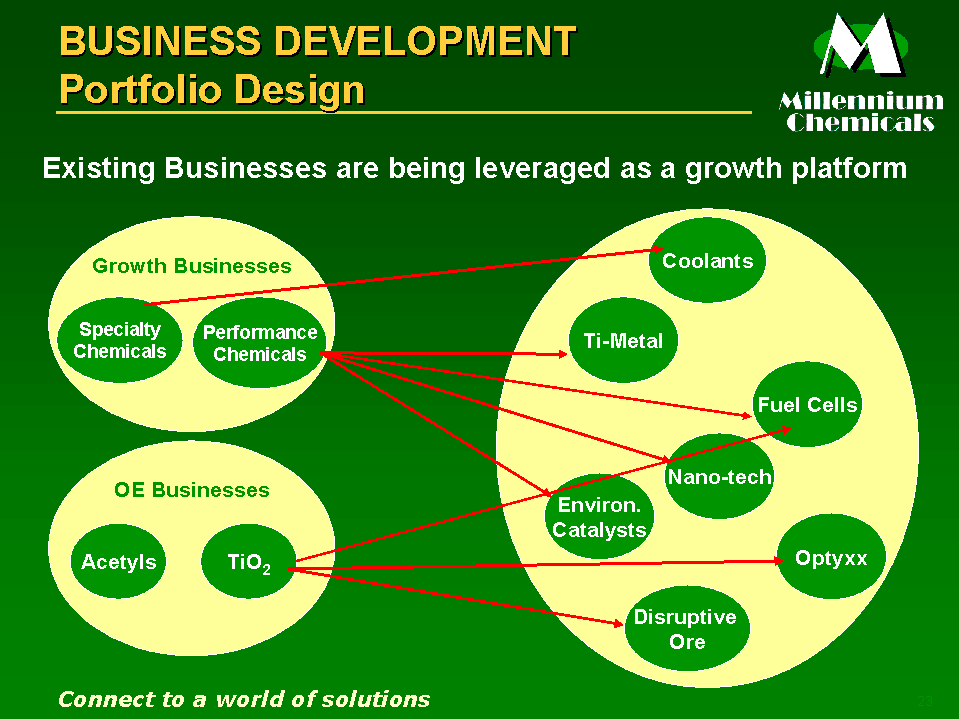
24
As this slide demonstrates, our identified growth opportunities relate to leveraging skills that are already present in our existing businesses. We have begun leveraging our competency platform, which includes gas and liquid particle formation, surface science and engineering, synthesized molecules, and inorganic compound extraction to create new business opportunities ranging from the new coolant molecules I described earlier to powder titanium metal production. In most cases, we already have products or intermediaries in the market place. Let me highlight a few.
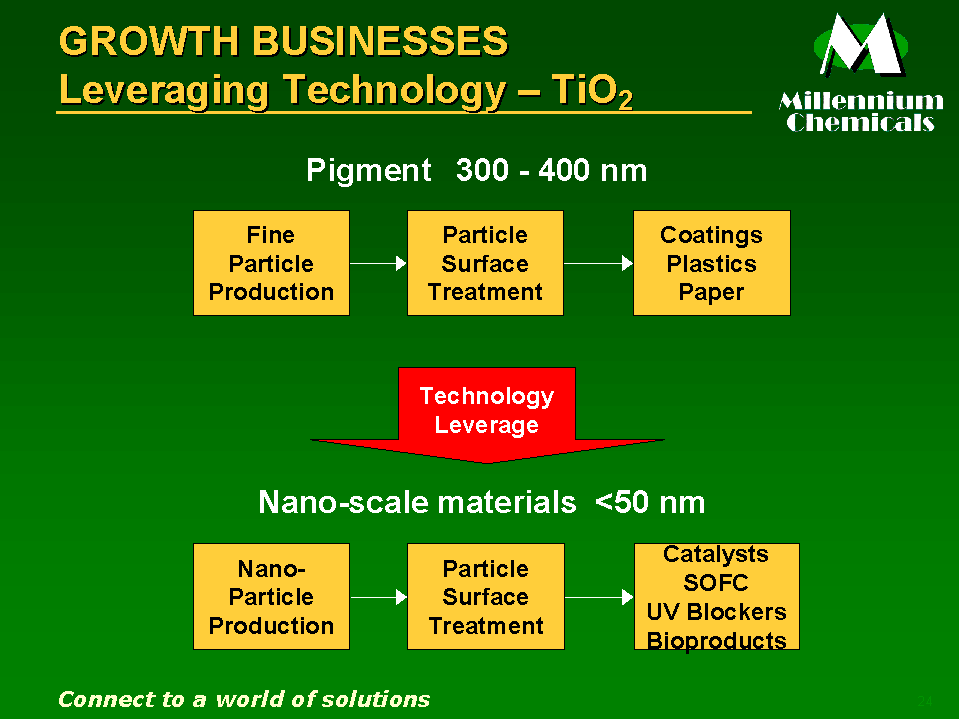
25
Over the years, we have developed and improved our competencies in the manufacture of micron-size materials in the 300 nano-meter range. The particles we manufacture are design in a specific shape and finished with a coating relating to a specific application, such as coatings, plastics, or paper production. We have leveraged that know-how into nano-scaled materials in the 50 nano-meter range to produce unique products for applications such as solid oxide fuel cells, UV blockers, and catalysts.
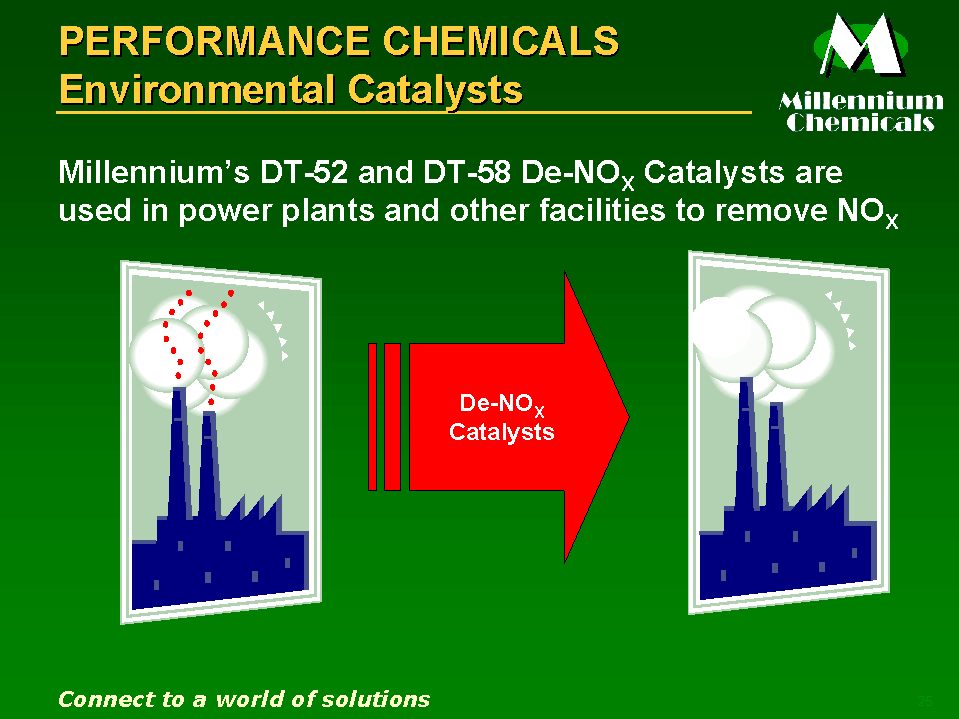
26
A specific example is our first generation of environmental catalyst products; DT-52 and DT-58. These products were design to remove NOX gases from power plants and other facilities. Starting from almost nothing, we have built a business that is now approaching a $30 million annual revenue pace.
As Clean Air legislation becomes the norm globally, we are well positioned to continue to grow of this business as well as leverage it to into other environmental improvement applications like coating highway sound barriers to neutralize certain auto emissions, an application currently being tested in Japan.
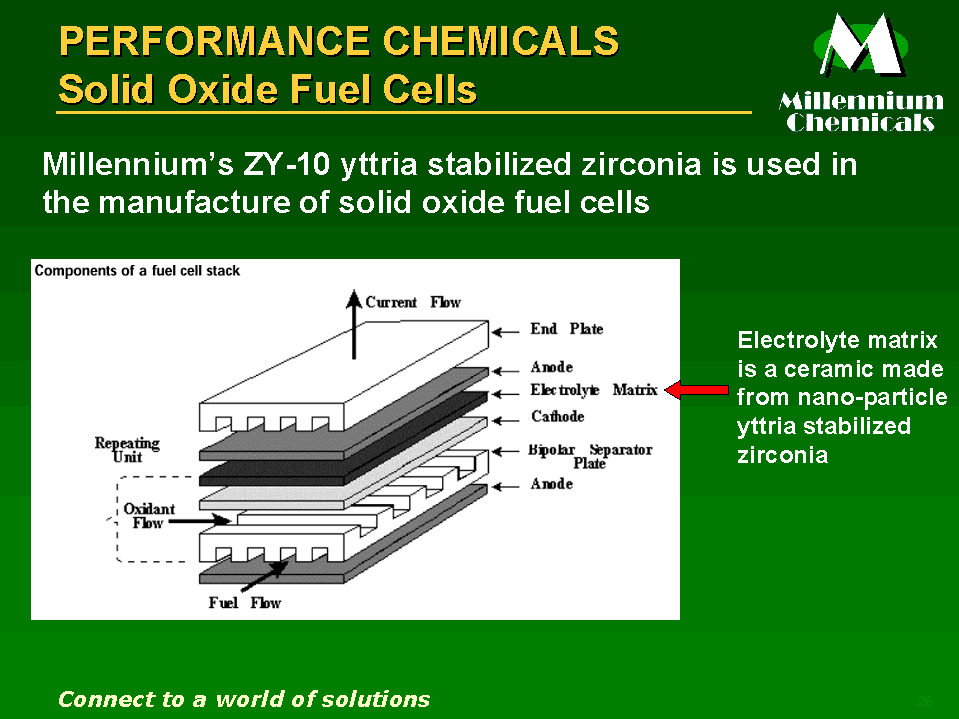
27
Another example, using the same technologies applied to zirconium oxides instead of TiO2 has led to the development of products designed specifically for the fuel cell market. Millennium yttriam-stabilized zirconium was created specifically for production of electrolyte matrix at the heart of a solid oxide fuel cell stack.
The market for solid oxide fuel cell systems is projected to grow to a $3.8 billion industry over the next ten years and we are talking to other materials producers about potential alliances where we can apply our process technology and scale-up experience to their pilot or lab-scale operations.
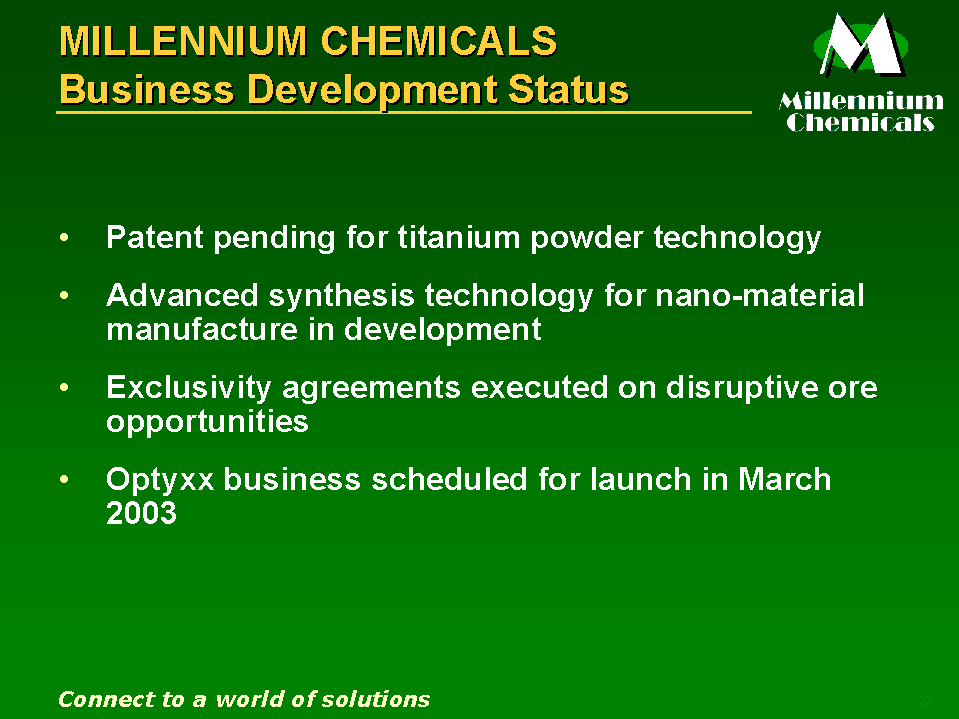
28
We don’t have sufficient time to discuss in any detail some of these other business development initiatives that we have already advanced from the concept to development stage gates, but examples of our progress are listed here. We have a patent pending for the direct manufacture of titanium metal powder that could dramatically reduce the cost of Ti-metals and open up a whole new market opportunity for Millennium.
On top of that, we are using our skills and competencies to accelerate and participate in unique titanium ore opportunities that could substantially change the game and the economics of the industry.
Not to forget the solution part of our business, after two years of development, we are on schedule to launch our Web-based process industry service business. Optyxx will provide subscription-based online production modeling, subscription-based product innovation services as well as fee-based diagnostic services. The business will be launched first to serve the paper industry but the diagnostics and high-throughput testing concepts the Optyxx model employs have potential for other process industry sectors.
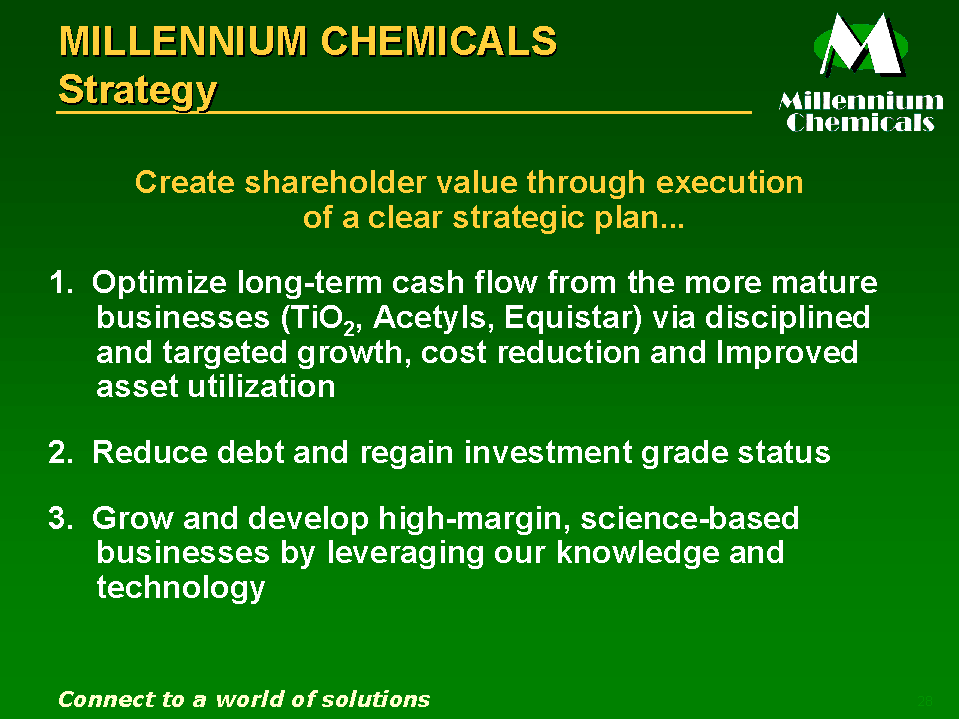
29
I’ll end my formal remarks by reminding you what our strategy is, a disciplined approach to optimizing long-term cash flow from our mature businesses, so as to return to investment grade credit status and fund internal development of these existing leading market share businesses as well as emerging businesses that are leveraged off of our demonstrated, science-based competencies.
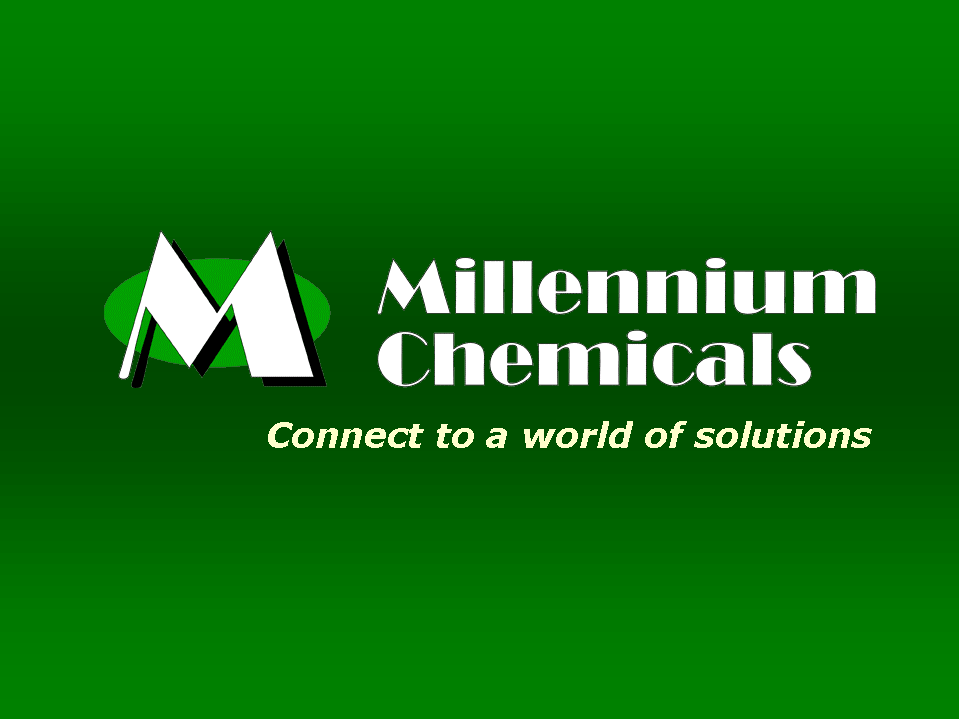
30
Thanks for your time and attention. We now would like to answer your questions.





























